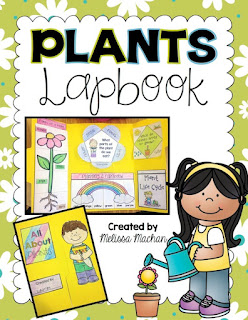Part of me has always wanted to try interactive notebooks. But being a first grade teacher and now kindergarten teacher I just know I do not have the time to dedicate and really be able to feel as though it's not time wasted on cutting and gluing. The management of interactive notebooking seems like more than I want to bite off with my little learners. I can just picture my class cutting things all wrong and having pages all stuck together.
On the other hand, when they are done correctly don't they just look so cute and fun. I'm positive there are teachers out there who rock at INB's. Unfortunately I don't think I am one of those teachers, at least not yet. Maybe in the future.
For now though, I've discovered and fallen in love with lapbooks. These are a smaller version of interactive notebooks that focus on one topic or theme. They seemed much more manageable for me and I really loved the final product. After seeing a few of these out there, I decided to make one for us to use for our plants unit.
This was so much fun to create, and even more fun for both my students and me to work through together. I tied each piece of this lapbook into a fun picture book to guide our lesson. Essentially this project takes about 6 days and was definitely appropriate for my little kiddos.
First, we read the book Splat the Cat: Oopsie Daisy by Rob Scotton. I love Splat books and this one is a nice quick intro to plants and what they need to grow. We used this quick foldable to list the things they need. This was an easy way to get the project started.
By the way, I think I forgot to say that I used colored file folders for this project. Before we began I folded all of the folders so they were ready to go. You could also use 11 x 14" construction to make these too. I like the folders because they are more sturdy and can stand up to be displayed if you want to.
The next day we read the book The Tiny Seed by Eric Carle and then created this little flip book to put inside our lapbook. There are a couple different options of the stages on the life cycle depending on how you'd like to teach it to your students. The students color, cut, and put the stages in order before we staple them together into the lapbooks.
On Day 3, we jumped into learning the parts of a plant by first reading From Seed to Plant by Gail Gibbons. We then completed this foldable where the children had to cut out labels for each part and then fill in the purpose of each part to glue under the flaps.
On the 4th day we read this adorable book called Tops & Bottoms by Janet Stevens. The kids loved this book the most I think! Then we started talking about how we all eat plants even if we didn't realize we do and how we eat all the different parts of the plant too. I made this chart to help them in their thinking when they completed this flower-shaped foldable.
For Day 5 we finished by thinking of plants and flowers of all the different colors of a rainbow. Again I read a great book called Planting a Rainbow by Lois Ehlert and made a chart to keep track of what we came up with. I had the children choose one plant for each color, write it under the flap and draw a quick picture too. We colored the rainbow on the front of it before making any of the cuts - just a quick tip since it's harder to color when the cuts are there.
Finally on Day 6 we added the cover pieces. You could choose to do this part first if you'd like. There are boy and girl pieces for the cover for you to choose from for your students.
I loved this so much that I really want to try to find or make more lapbooks for my class to use. It was such a fun and interactive (obviously ;) way to teach. If you want to try it out in your classroom, click on the picture below to head over to my Teachers Pay Teachers store.
And maybe someday I will be ready to jump into the world of interactive notebooks. But for now, I'm loving lapbooks!
Hope you enjoy it too!


















